Page 24 of 498
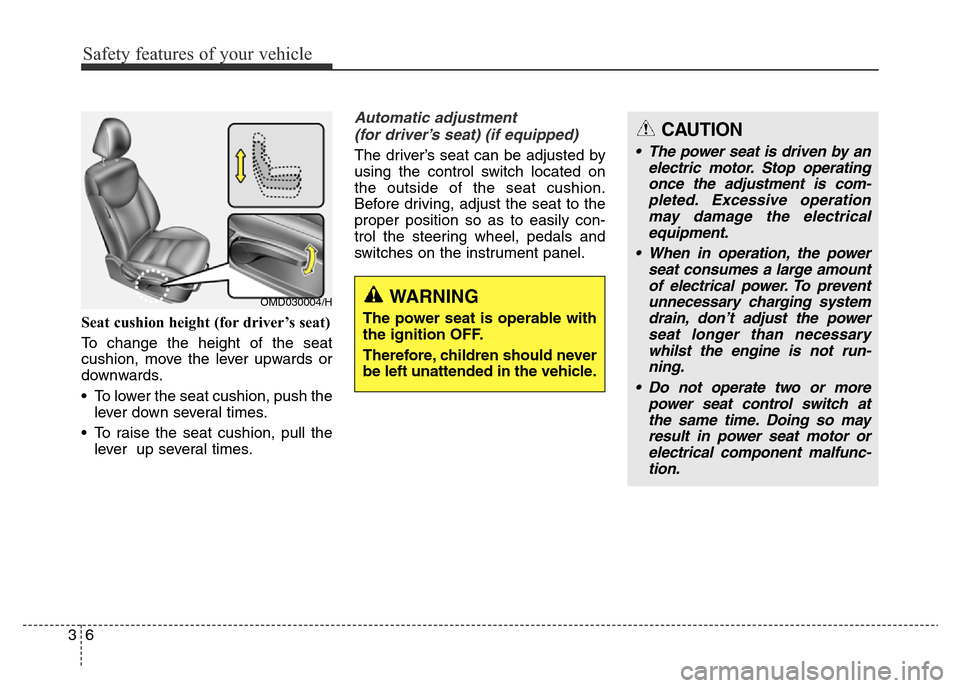
Safety features of your vehicle
6 3
Seat cushion height (for driver’s seat)
To change the height of the seat
cushion, move the lever upwards or
downwards.
• To lower the seat cushion, push the
lever down several times.
• To raise the seat cushion, pull the
lever up several times.
Automatic adjustment
(for driver’s seat) (if equipped)
The driver’s seat can be adjusted by
using the control switch located on
the outside of the seat cushion.
Before driving, adjust the seat to the
proper position so as to easily con-
trol the steering wheel, pedals and
switches on the instrument panel.
OMD030004/HWARNING
The power seat is operable with
the ignition OFF.
Therefore, children should never
be left unattended in the vehicle.
CAUTION
• The power seat is driven by an
electric motor. Stop operating
once the adjustment is com-
pleted. Excessive operation
may damage the electrical
equipment.
• When in operation, the power
seat consumes a large amount
of electrical power. To prevent
unnecessary charging system
drain, don’t adjust the power
seat longer than necessary
whilst the engine is not run-
ning.
• Do not operate two or more
power seat control switch at
the same time. Doing so may
result in power seat motor or
electrical component malfunc-
tion.
Page 26 of 498
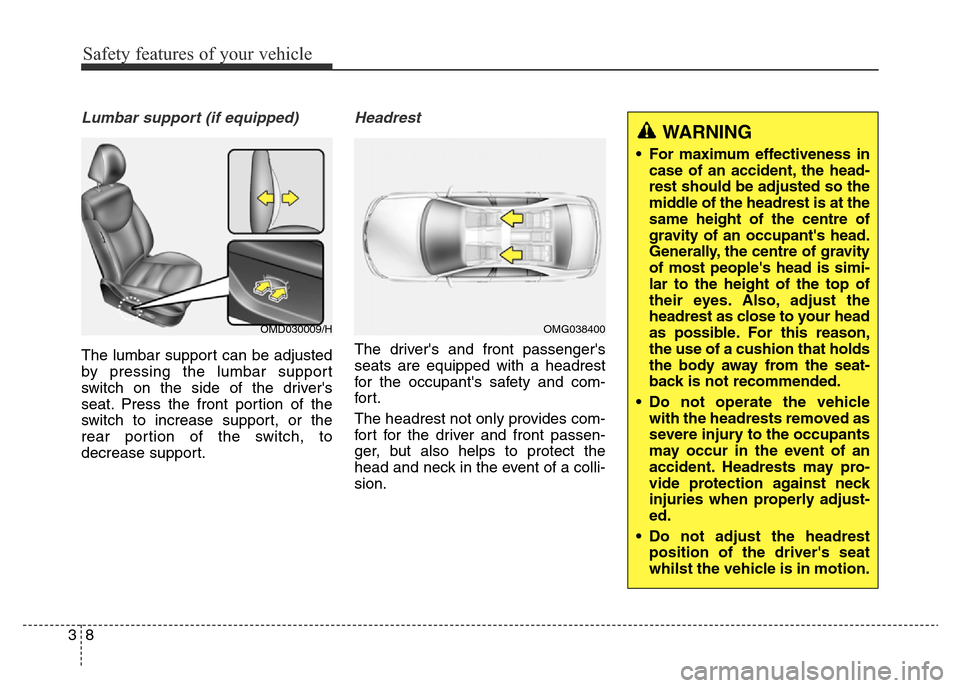
Safety features of your vehicle
8 3
Lumbar support (if equipped)
The lumbar support can be adjusted
by pressing the lumbar support
switch on the side of the driver's
seat. Press the front portion of the
switch to increase support, or the
rear portion of the switch, to
decrease support.
Headrest
The driver's and front passenger's
seats are equipped with a headrest
for the occupant's safety and com-
for t.
The headrest not only provides com-
fort for the driver and front passen-
ger, but also helps to protect the
head and neck in the event of a colli-
sion.
OMD030009/HOMG038400
WARNING
• For maximum effectiveness in
case of an accident, the head-
rest should be adjusted so the
middle of the headrest is at the
same height of the centre of
gravity of an occupant's head.
Generally, the centre of gravity
of most people's head is simi-
lar to the height of the top of
their eyes. Also, adjust the
headrest as close to your head
as possible. For this reason,
the use of a cushion that holds
the body away from the seat-
back is not recommended.
• Do not operate the vehicle
with the headrests removed as
severe injury to the occupants
may occur in the event of an
accident. Headrests may pro-
vide protection against neck
injuries when properly adjust-
ed.
• Do not adjust the headrest
position of the driver's seat
whilst the vehicle is in motion.
Page 28 of 498
Safety features of your vehicle
10 3
Reinstall
To reinstall the headrest :
1. Put the headrest poles (2) into the
holes whilst pressing the release
button (1).
2. Recline the seatback (4) with the
recline lever or switch (3).3. Adjust the headrest to the appro-
priate height.
OMD034063R
OMD034012R
■Type A
■ Type B
WARNING
NEVER allow anyone to travel in
a seat with the headrest
removed.
WARNING
Always make sure the headrest
locks into position after rein-
stalling and adjusting it properly.
Page 30 of 498
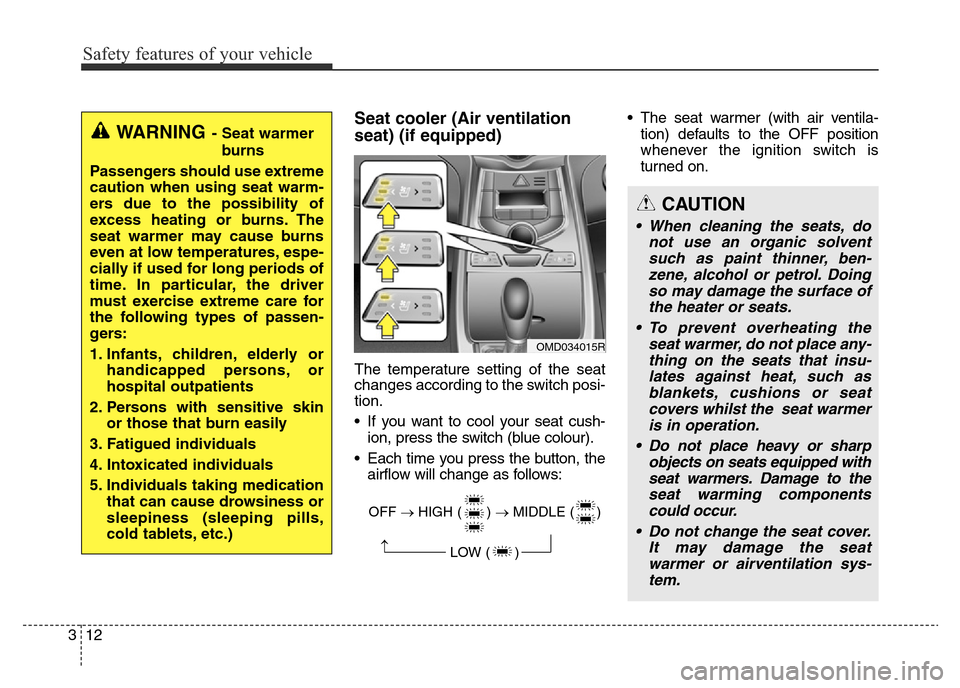
Safety features of your vehicle
12 3
Seat cooler (Air ventilation
seat) (if equipped)
The temperature setting of the seat
changes according to the switch posi-
tion.
• If you want to cool your seat cush-
ion, press the switch (blue colour).
• Each time you press the button, the
airflow will change as follows:• The seat warmer (with air ventila-
tion) defaults to the OFF position
whenever the ignition switch is
turned on.
OMD034015R
WARNING- Seat warmer
burns
Passengers should use extreme
caution when using seat warm-
ers due to the possibility of
excess heating or burns. The
seat warmer may cause burns
even at low temperatures, espe-
cially if used for long periods of
time. In particular, the driver
must exercise extreme care for
the following types of passen-
gers:
1. Infants, children, elderly or
handicapped persons, or
hospital outpatients
2. Persons with sensitive skin
or those that burn easily
3. Fatigued individuals
4. Intoxicated individuals
5. Individuals taking medication
that can cause drowsiness or
sleepiness (sleeping pills,
cold tablets, etc.)
CAUTION
• When cleaning the seats, do
not use an organic solvent
such as paint thinner, ben-
zene, alcohol or petrol. Doing
so may damage the surface of
the heater or seats.
• To prevent overheating the
seat warmer, do not place any-
thing on the seats that insu-
lates against heat, such as
blankets, cushions or seat
covers whilst the seat warmer
is in operation.
• Do not place heavy or sharp
objects on seats equipped with
seat warmers. Damage to the
seat warming components
could occur.
• Do not change the seat cover.
It may damage the seat
warmer or airventilation sys-
tem.
OFF → HIGH ( ) → MIDDLE ( )
LOW ( )
→
Page 31 of 498
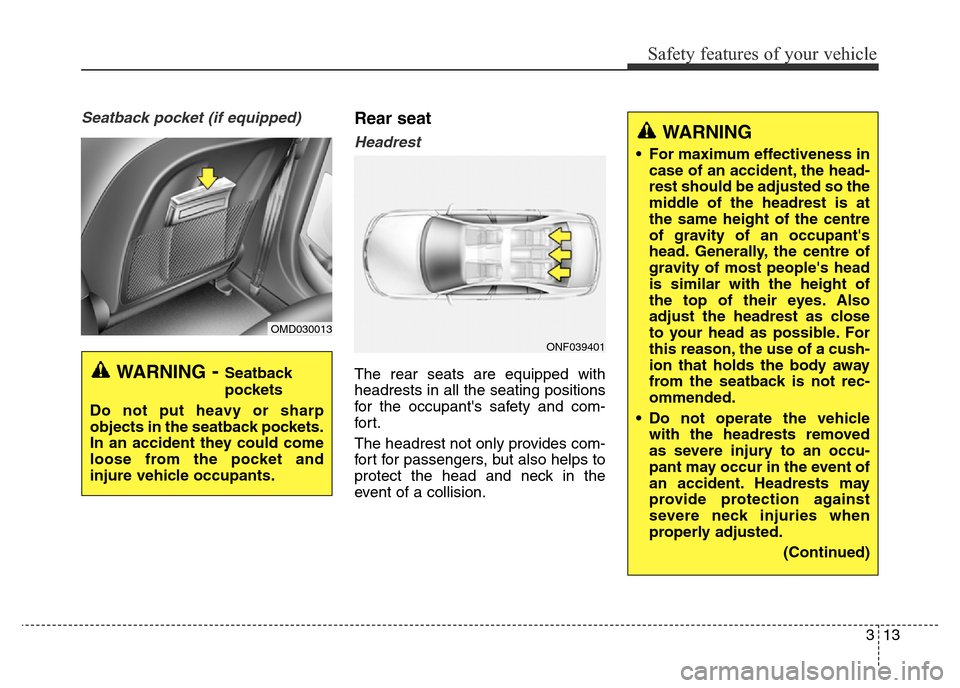
313
Safety features of your vehicle
Seatback pocket (if equipped)Rear seat
Headrest
The rear seats are equipped with
headrests in all the seating positions
for the occupant's safety and com-
for t.
The headrest not only provides com-
fort for passengers, but also helps to
protect the head and neck in the
event of a collision.WARNING- Seatback
pockets
Do not put heavy or sharp
objects in the seatback pockets.
In an accident they could come
loose from the pocket and
injure vehicle occupants.
OMD030013
ONF039401
WARNING
• For maximum effectiveness in
case of an accident, the head-
rest should be adjusted so the
middle of the headrest is at
the same height of the centre
of gravity of an occupant's
head. Generally, the centre of
gravity of most people's head
is similar with the height of
the top of their eyes. Also
adjust the headrest as close
to your head as possible. For
this reason, the use of a cush-
ion that holds the body away
from the seatback is not rec-
ommended.
• Do not operate the vehicle
with the headrests removed
as severe injury to an occu-
pant may occur in the event of
an accident. Headrests may
provide protection against
severe neck injuries when
properly adjusted.
(Continued)
Page 32 of 498
Safety features of your vehicle
14 3
Adjusting the height up and down
To raise the headrest, pull it up (1).
To lower the headrest, push and hold
the release button (2) on the head-
rest support and lower the headrest
(3).Removal
To remove the headrest, raise it as far
as it can go then press the release
button (1) whilst pulling upward (2).
To reinstall the headrest, put the
headrest poles (3) into the holes
whilst pressing the release button
(1). Then adjust it to the appropriate
height.
(Continued)
• When there is no occupant in
the rear seats, adjust the
height of the headrest to the
lowest position. The rear seat
headrest can reduce the visi-
bility of the rear area.
OMD030016
WARNING
Make sure the headrest locks in
position after adjusting it to
properly protect the occupants.
OMD030015
Page 34 of 498
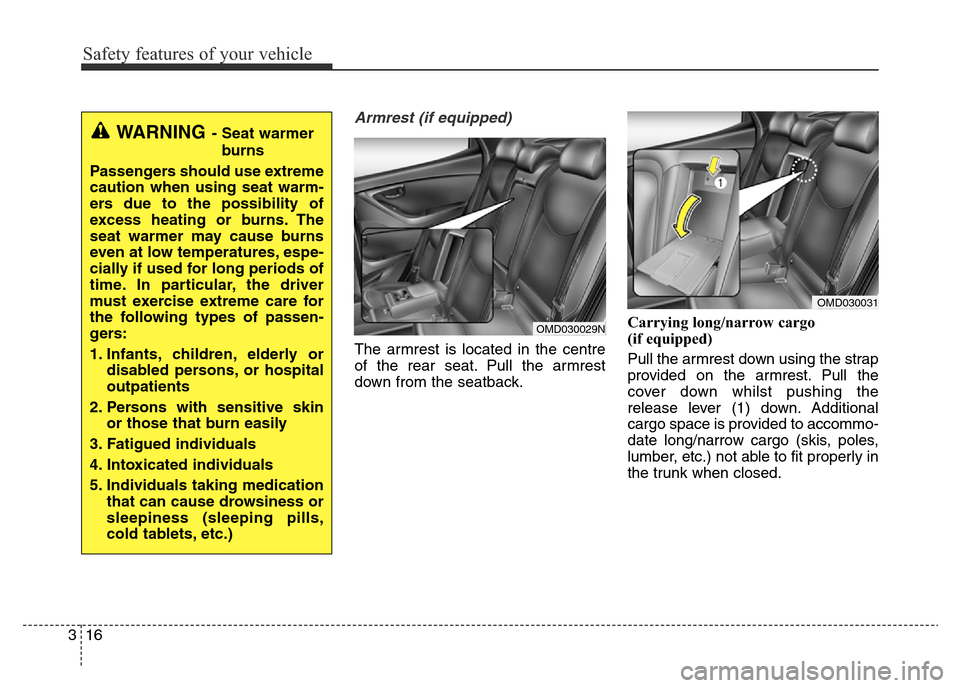
Safety features of your vehicle
16 3
Armrest (if equipped)
The armrest is located in the centre
of the rear seat. Pull the armrest
down from the seatback.Carrying long/narrow cargo
(if equipped)
Pull the armrest down using the strap
provided on the armrest. Pull the
cover down whilst pushing the
release lever (1) down. Additional
cargo space is provided to accommo-
date long/narrow cargo (skis, poles,
lumber, etc.) not able to fit properly in
the trunk when closed.
OMD030029N
WARNING- Seat warmer
burns
Passengers should use extreme
caution when using seat warm-
ers due to the possibility of
excess heating or burns. The
seat warmer may cause burns
even at low temperatures, espe-
cially if used for long periods of
time. In particular, the driver
must exercise extreme care for
the following types of passen-
gers:
1. Infants, children, elderly or
disabled persons, or hospital
outpatients
2. Persons with sensitive skin
or those that burn easily
3. Fatigued individuals
4. Intoxicated individuals
5. Individuals taking medication
that can cause drowsiness or
sleepiness (sleeping pills,
cold tablets, etc.)
OMD030031
Page 35 of 498
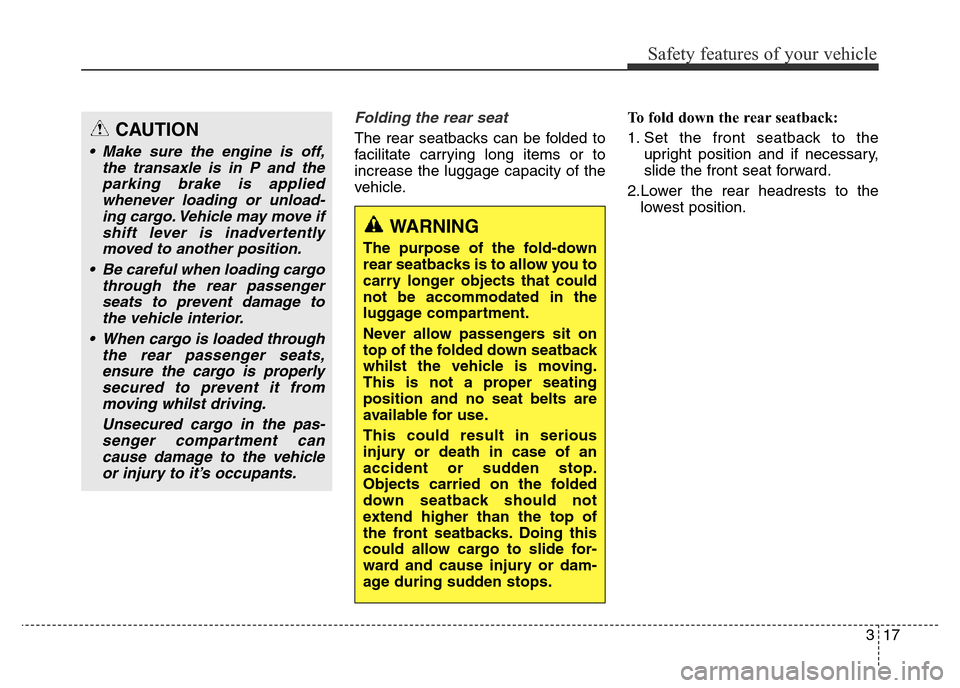
317
Safety features of your vehicle
Folding the rear seat
The rear seatbacks can be folded to
facilitate carrying long items or to
increase the luggage capacity of the
vehicle.To fold down the rear seatback:
1. Set the front seatback to the
upright position and if necessary,
slide the front seat forward.
2.Lower the rear headrests to the
lowest position.CAUTION
• Make sure the engine is off,
the transaxle is in P and the
parking brake is applied
whenever loading or unload-
ing cargo. Vehicle may move if
shift lever is inadvertently
moved to another position.
• Be careful when loading cargo
through the rear passenger
seats to prevent damage to
the vehicle interior.
• When cargo is loaded through
the rear passenger seats,
ensure the cargo is properly
secured to prevent it from
moving whilst driving.
Unsecured cargo in the pas-
senger compartment can
cause damage to the vehicle
or injury to it’s occupants.
WARNING
The purpose of the fold-down
rear seatbacks is to allow you to
carry longer objects that could
not be accommodated in the
luggage compartment.
Never allow passengers sit on
top of the folded down seatback
whilst the vehicle is moving.
This is not a proper seating
position and no seat belts are
available for use.
This could result in serious
injury or death in case of an
accident or sudden stop.
Objects carried on the folded
down seatback should not
extend higher than the top of
the front seatbacks. Doing this
could allow cargo to slide for-
ward and cause injury or dam-
age during sudden stops.